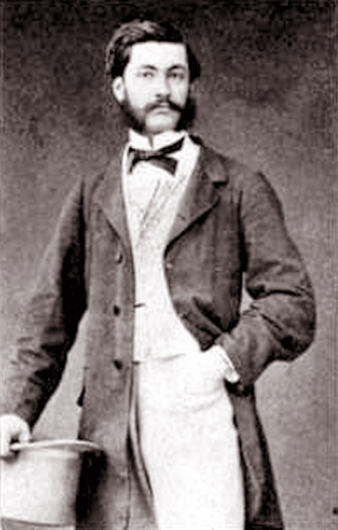Louis Le Prince
Louis Aimé Augustin Le Prince , born August 28, 1842 in Metz ; † September 16, 1890 (lost), was a French chemist , inventor and film pioneer who, in 1888, made the first chronophotographic recordings in history with a camera for paper film.
biography
Louis Le Prince was born the son of an officer in the French army, Louis Abraham Ambroise Leprince (September 16, 1799– August 2, 1855), who was a friend of the photography pioneer Louis Jacques Mandé Daguerre . Through him, Le Prince became familiar with the techniques of photography at an early age . He allegedly studied chemistry and physics at the University of Leipzig , where he befriended the English engineer John Whitley. Whitley invited Le Prince to Leeds in 1866 , where he worked as an engineer in the Whitley family's business. In 1869, Le Prince married Whitley's sister Elizabeth. Together with her he founded the Leeds Technical School of Arts in 1871.
In 1881 Le Prince moved with his family to New York to work as a representative for the Whitley company. When the Whitley contract ended, Le Prince stayed in New York and began working as an agent for several French artists. He also continued experiments on capturing moving images .
Inspired by the work of Eadweard Muybridge and other pioneers, he developed a camera in 1886 that made it possible to record moving images with the help of 16 lenses. The disadvantage, however, was that each picture was taken from a slightly different perspective. Le Prince filed a patent for this camera, which was finally granted in 1888.

In 1887 Louis Le Prince returned to Leeds without his family. There he developed a camera with only one taking lens, for which he used the paper-based roll film ( stripping film ) marketed by George Eastman as film material . The patent for this camera was granted to him in October 1888. That month he filmed pictures of the Whitley family in their home garden in Roundhay ( Roundhay Garden Scene ) as well as footage of traffic on Leeds Bridge ( Traffic Crossing Leeds Bridge ) . Photographic copies of both films still exist today. In the same year he obtained US citizenship.
In 1890, Le Prince planned to return to New York to present his camera and films. On September 12, 1890, he wanted to travel from Bourges to Dijon to visit his brother there. According to this, Le Prince is said to have boarded a train to Paris on the 16th to meet friends from England. However, he never arrived in Paris and, despite an intensive search by his family and the police, disappeared without a trace. What exactly happened is still unclear today.
The University of Leeds named its center for film, photography and television after Louis Le Prince.
A replica of his 1888 cameras has been around for a number of years.
Individual evidence
- ↑ other authors name 1841 as the year of birth, cf. Rawlence: The Missing Reel , p. 87.
literature
- Jean-Jacques Aulas, Jacques Pfend: Louis Aimé Augustin Leprince, inventeur et artiste, précurseur du cinéma . In: 1895. Revue de l'Association Française de Recherche sur l'Histoire du Cinéma. No. 32, 2000, pp. 9-74.
- Christopher Rawlence: The Missing Reel. The Untold Story of the Lost Inventor of Moving Pictures. Collins, London, 1990; Fontana-Harper-Collins, 1991. ISBN 0-00-637328-3 .
- Christopher Rawlence: Why did Augustin Le Prince disappear? The mysterious story of the inventor of moving images . Publishing company, Cologne 1991, ISBN 3-8025-2209-5 .
Web links
- Louis Le Prince in the Internet Movie Database (English)
- Adventures In Cybersound Full Bio (in English)
- Video Video clip of Le Prince's first film
- LLP website of the Louis Le Prince Center at the University of Leeds
- Le Prince
| personal data | |
|---|---|
| SURNAME | Le Prince, Louis |
| ALTERNATIVE NAMES | Le Prince, Louis Aimé Augustin |
| BRIEF DESCRIPTION | French chemist, inventor and film pioneer |
| DATE OF BIRTH | August 28, 1842 |
| PLACE OF BIRTH | Metz , France |
| DATE OF DEATH | after September 16, 1890 |

